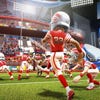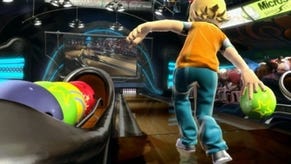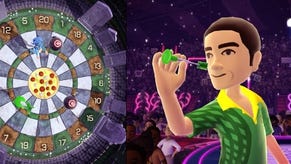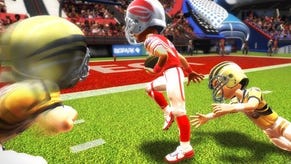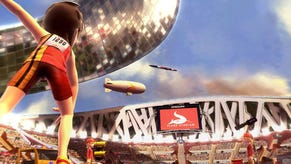Kinect Sports Season 2 Review
Having a ball.
People are really angry with Rare. Read any features or news items about the once-beloved developer, and you can safely bet that the comments below will feature indignant demands for a new Killer Instinct, more Banjo Kazooie or Perfect Dark. Keep reading and someone will probably use the word "boycott" or actively wish the studio out of business, punishment for making games for them rather than us. "Why doesn't Rare make proper games any more?" is the pleading subtext.
These are clearly heartfelt opinions, and the passion gamers had for the Rare of old shouldn't be dismissed. But the venom seems out of proportion and largely driven by the fact that Rare's Kinect Sports is a motion control game and doesn't have buttons and levels and others things we associate with "real" games. Yet it has more depth and variety than its genetic ancestors, the joystick-wrecking likes of Hyper Sports, the Ep sports compilations and Daley Thompson's Decathlon - and I don't recall any ominous predictions that those titles would lead to the death of gaming as we know it. In fact, I'm pretty sure we had fun with them.
Fun is very much on the agenda where Kinect Sports Season 2 is concerned. Big, bouncy fun that everyone can enjoy, not the grim, determined fun that comes from a well-executed headshot. Xbox Avatars jump around and do silly things in the background, blasts of cheesy pop herald every success, while The X-Factor's Peter Dickson supplies more tongue-in-cheek commentary, with just enough irony to take the sting out of any failure.
And you will fail, not because of wonky motion control but because Kinect Sports has more than just a "jump around and act like a tit" mentality. Even at the rookie level, player skill is demanded and rewarded, even if the presentation is sugar-coated and the game gives a helping hand to ensure that the most uncertain player feels like they've achieved something. Try mucking about on the Champion stages and you'll get humiliated.
For this second season, the roster of sports on offer feels more varied, and there's a better mixture of events that require frantic jogging and throwing and games that require patience and finesse. It's less exhausting overall, which makes it easier to enjoy longer play sessions encompassing more sports.
Of the six events, three are immediately and gratifyingly enjoyable. Golf is by far the best and, as I said in an earlier preview, it could easily stand on its own as a spin-off title. The control is intuitive and the game is excellent at reading the difference between different powered shots. This is the holy grail of motion gaming - to allow the player to perform naturally and have their intentions seamlessly realised on-screen. When you take a swing with the intention of getting the ball just to the left of the fairway, lining up a birdie-earning drive to the green, and it lands just where you wanted, it's a deeply satisfying and impressive use of Kinect.
Golf also showcases Kinect Sports' strengths in other areas. Natural gestures such as adopting a "lookout" pose or squatting down to inspect the green mean that the mood is never broken, while voice commands mean that changing clubs doesn't mean changing stance. Indeed, the whole game makes superb use of Kinect's microphone, allowing you to go from main menu to gameplay without once waving your hands over options. Every button has a voice alternative, and it's so streamlined that you wonder why more Kinect games don't use this feature more.
Darts is also excellent, using a cleverly designed targeting system that offers just enough help to make it playable for all, yet still requiring a steady aim and confident throw. As with golf, the game reads your intentions with uncanny accuracy, but you'll endure enough near-misses and abject cock-ups to reassure you that the ones that do hit home are down to your skill and not the game tugging you towards victory. As an indication of how well the game trains you to do better, my nine-year-old son was landing treble twenties after only a couple of games, despite never having played darts in his life. His jubilation at eventually beating the AI player was utterly genuine and honestly earned.
Baseball, while hardly original, is the third sport that you'll come back to time and again. It captures the elation of a hefty home run, but it's also accurate enough that knocking it out of the park is down to muscle memory and timing rather than blind luck. Once you've got the feel for the way the game pitches, you're able to direct shots to different areas of the field, play a little more tactically and get those bases loaded. It's hardly an ocean of depth, but it's plenty for this sort of party game.
Skiing isn't quite as essential as the others, but is still a tactile pleasure to play. It plays almost exactly as you'd expect; crouching to increase speed, leaning to steer through the slalom and jumping to clear ramps. What it does extremely well is boil the thrill of the sport down into something accessible. Hurtling down the slope is a blast, and the game's exuberant presentation enhances the adrenalin rush in all the right ways.
That same focus also means that skiing doesn't quite have the same long-term appeal as the other sports. A game of baseball will never play the same way twice, while the slalom courses will always be the same. The innate appeal doesn't diminish, but the challenge becomes routine rather too early.
Only tennis and American football let the side down. Neither is completely broken, but they each have core issues that can make them frustrating to play.
American football stumbles because of tackling. Calling the plays, throwing to the receivers then running for the end zone all work fine. It's even the sport with the most strategic depth: nine plays on offer, each with three receivers to throw to, mean that you actually have to think your way up the field. Not with the same rigour as a Madden title, but as with baseball, it's just enough to add longevity and skill to what could easily be a mindless bout of throwing and jogging.
The tackles, however, introduce an unwelcome random element. Earlier builds of the game allowed you to dodge the linebackers, but that's been removed for the final version. So you pound your feet to gain yards, dodging some tackles but then being felled by another for no apparent reason. Given that this is the most physically demanding of the sports on offer, it's incredibly frustrating to put your all into a run, knowing that how far you get will depend more on random chance than your own ability. Hopefully, the dodging can be reinstated through a patch, as without it the long-term appeal of this interesting event is severely hampered.
And finally, tennis feels hobbled by unconvincing hits and a general lack of control. Often, the ball clearly doesn't actually hit the racket, which makes gauging returns a hit and miss affair. Sometimes, a backswing will find its target, even against the evidence of your own eyes (and that of the replay camera), while at other times the ball sails on past and you cede a point. It's a shame, since tennis has the potential to be the defining motion gaming sport, but the accuracy and control on offer here doesn't match up to the rest of the package.
All the events are playable in local multiplayer and online, while challenges allow you to dare Xbox Live friends to beat your score on the various mini-games. All the sports have a mini-game spin-off, except American Football for some reason, but it's not a massively inspired selection. You can hit golf balls at targets, hit tennis balls at targets, hit as many home runs as possible, throw darts at balloons or ski down an obstacle course, but as mini-games go, this is entry-level stuff and you'd expect a studio that made the likes of Viva Pinata to come up with something a little more inspired.
Despite this, there's nothing here to explain the vitriol that Rare's move to motion gaming has provoked. Kinect Sports is a fun game, it's a well designed and carefully structured game and it will likely stay in family rotation until the next one arrives in 2012. Season 2's lowest points are more disappointment than tragedy, and at its strongest it's easily one of the best and most technically impressive Kinect titles around.
There's nuance and depth here that goes beyond most people's preconceptions of what motion gaming is about, and yet the game never loses sight of the fact that anybody should be able to get up, have a try and have fun doing so. The sad part is that more studios aren't using the technology to this standard.







